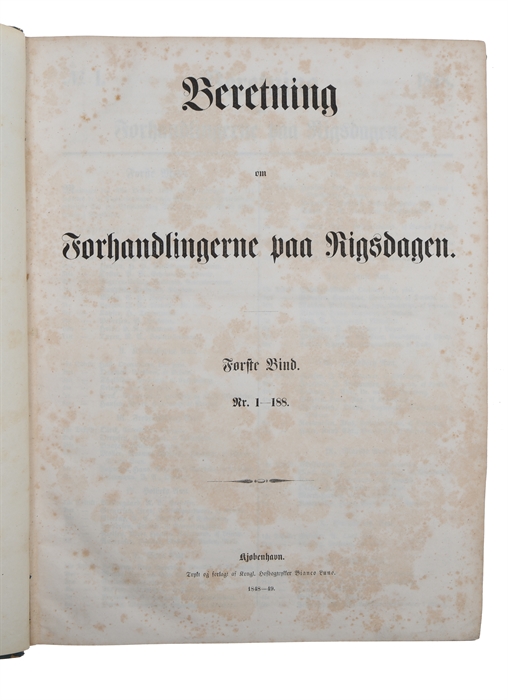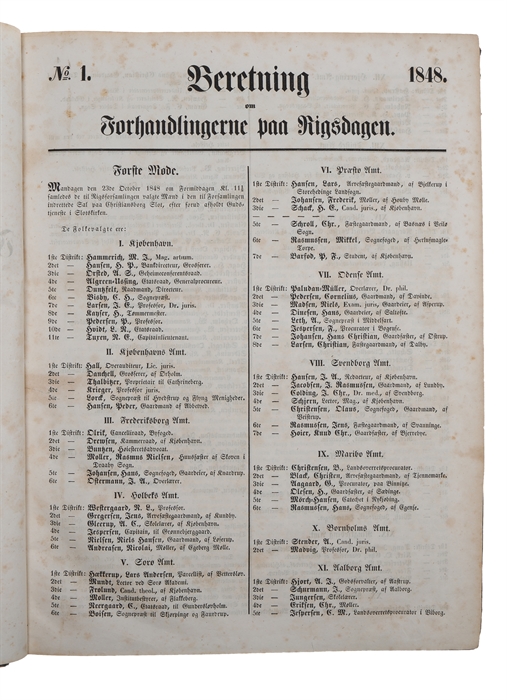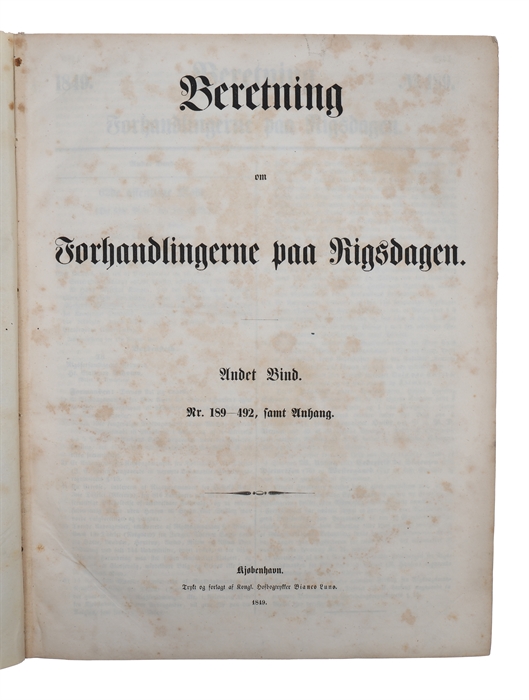FROM ABSOLUTE MONARCHY TO A CONSTITUTIONAL MONARCHY - DENMARK'S FIRST DEMOCRATIC CONSTITUTION
- DEN GRUNDLOVGIVENDE RIGSDAGSFORSAMLING
Beretning om Forhandlingerne paa Rigsdagen. 2 vold, nr. 1-188 og 189-492 + Anhang. (Komplet).
Kjøbenhavn, Bianco Luno, 1848-49 + 1849.
4to. Two volumes, both in the original blue boards with paper title-label to spine. Wear to extremities, hinges and edges of boards with loss of the blue paper, primarily affecting vol. 2. Inner hinge on vol. 2 split. Occassional brownspotting throughout. 3906, LXVI columns. (= 1986 pp.).
Scarce first printing of all the minutes of The Danish Constitutional Assembly 1848-49. The Danish Constitutional Assembly of 1848-1849 was a pivotal event in Denmark’s political history, marking the transition from absolute monarchy to a constitutional monarchy, Denmark's first democratic constitution. This assembly was organized in the wake of revolutionary movements sweeping across Europe in 1848 which sparked widespread demands for political reforms – also in Denmark. The assembly’s main achievement was the drafting and adoption of Denmark’s first democratic constitution, known as the Grundlov (The Constitution), on June 5, 1849, thus ushered a new era of constitutional rule and laying the groundwork for the modern Danish state. The constitution applying equally in the Realm of Denmark: Denmark proper, Greenland and the Faroe Islands. ”At the beginning of the 1800s demands for political reform grew around Europe. Inspired by, for example, Norway’s constitution of 1814 and the July Revolution in Paris of 1830, a national liberal movement emerged in Denmark rooted in the middle classes of Copenhagen. The national liberals made demands for representative government guaranteed by a free constitution. The peasantry organised themselves into the Society of the Friends of Peasants, which supported the liberal demands, for instance, through the weekly publication “the Friend of the Peasantry. Originating in Paris, a new wave of revolutions swept across Europe in 1848. Social and democratic reforms were demanded. In many places the calls for democracy became linked to national questions.” (National Museum of Denmark).
“In 1848, Denmark was on the periphery of revolutionary Europe. In March, the outbreak of revolution in several European cities inspired Danish liberals and radicals to convene mass meetings that demanded a free constitution and universal suffrage. King Frederik VII and his advisors were equally affected by the European developments and abolished absolutism before the threat of violent conflict could be realised in the capital. The developments of March 1848 initiated a constitutional struggle that ended on 5 June 1849 when Frederik VII signed the country’s first free constitution, which came to be known as the June Constitution. In contrast to the experience in many European states, counter-revolution was absent in the Danish kingdom, and the June Constitution remained in function beyond the revolutionary years. The exception to this picture of a non-violent, almost gentle revolution are of course the developments in the duchies of Schleswig, Holstein and Lauenburg, where violence erupted in March 1848. Thus, the constitutional struggle in the capital was played out alongside the First Schleswig War (1848–1851) in Jutland and the duchies.” (Nørgaard, A Battle for Democracy The Concept of Democracy in the Constitutional Struggle, Denmark 1848–1849).
Order-nr.: 61592




